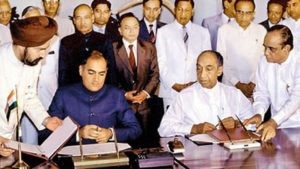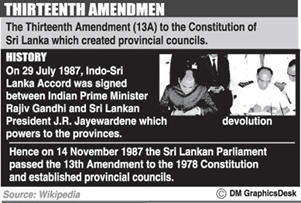Description

Disclaimer: Copyright infringement not intended.
Context
- Recently, PM Modi expressed the hope that Wickremesinghe would be committed to implementing the 13th Amendment to Sri Lanka’s constitution — which flows from the Indo-Sri Lanka Accord of 1987.
Background
The beginning
- Sri Lanka, from the early part of the 1980s, was facing an increasingly violent ethnic strife.
- The origins of this conflict can be traced to the independence of the island from Britain in 1948.
- At the time, a Sinhala majority government was instituted which passed legislation that was deemed discriminatory against the substantial Tamil minority population.
- In the 1970s, two major Tamil parties united to form the Tamil United Liberation Front (TULF) that started agitation for a separate state of Tamil Eelam within the system in a federal structure in the north and eastern Sri Lanka that would grant the Tamils greater autonomy.
- However, the enactment of the sixth amendment of the Sri Lankan Constitution in August 1983 classified all separatist movements as unconstitutional, effectively rendering the TULF ineffective.
- Outside the TULF, however, factions advocating more radical and militant courses of action soon emerged, and the ethnic divisions started flaring into a violent civil war.
Indian involvement
- Indian intervention in Sri Lankan civil war became inevitable as that civil war threatened India's "unity, national interest and territorial integrity."
- This threat came in two ways: On the one hand external powers could take advantage of the situation to establish their base in Sri Lanka thus posing a threat to India, on the other hand, the LTTE's dream of a sovereign Tamil Eelam comprising all the Tamil-inhabited areas (of Sri Lanka and India) posed a threat to India's territorial integrity.
- India had, initially under Indira Gandhi and later under Rajiv Gandhi, provided support to Tamil interests from the very conception of the secessionist movement. This included providing sanctuary to the separatists, as well as supporting the operations training camps for Tamil guerrillas in Tamil Nadu of which the LTTE emerged as the strongest force.
- This was both as a result of a large Tamil community in South India, as well as India's regional security and interests which attempted to reduce the scope of foreign intervention, especially those linked to the United States, Pakistan, and China.
- To this end, the Indira Gandhi government sought to make it clear to Sri Lankan President J. R. Jayewardene that armed intervention in support of the Tamil movement was an option India would consider if any diplomatic solutions should fail.
- Following the anti-Tamil riots, the Tamil rebel movement grew progressively strong and increasingly violent. However, after Indira Gandhi's assassination, Indian support for the militant movement decreased. However, the succeeding Rajiv Gandhi government attempted to re-establish friendly relations with its neighbours. It still however maintained diplomatic efforts to find a solution to the conflict as well as maintaining covert aid to the Tamil rebels.
- From 1985 however, the Sri-Lankan Government started rearming itself extensively for its anti-insurgent role with support from Pakistan, Israel, Singapore and South Africa.
- In 1986, the campaign against the insurgency was stepped up and in 1987, retaliating an increasingly bloody insurgent movement, Operation Liberation was launched against LTTE strongholds in Jaffna Peninsula, involving nearly four thousand troops, supported by helicopter gunships as well as ground attack aircraft.
- In June 1987, the Sri Lankan Army laid siege on the town of Jaffna.
- As civilian casualties grew, calls grew within India to intervene in what was increasingly seen in the Indian (and Tamil) media as a developing humanitarian crisis, especially with reports use of aerial support against rebel positions in civilian areas.
- India, which had a substantial Tamil population in South India faced the prospect of a Tamil backlash at home, called on the Sri Lankan government to halt the offensive in an attempt to negotiate a political settlement.
- However, the Indian efforts were futile. Added to this, in the growing involvement of Pakistani and Israeli advisors, it was necessary for Indian interest to mount a show of force.
- Failing to negotiate an end to the crisis with Sri Lanka, India announced on 2 June 1987 that it would send a convoy of unarmed ships to northern Sri Lanka to provide humanitarian assistance but this was intercepted by the Sri Lankan Navy and turned back.
- Following the failure of the naval mission, the decision was made by the Indian government to mount an airdrop of relief supplies in support of rebel forces over the besieged city of Jaffna. On 4 June 1987, in a blatant show of force, the Indian Air Force Mounted Operation Poomalai in broad daylight. Five An-32s of the Indian Air Force under cover of heavily armed Indian fighter jets flew over Jaffna to airdrop 25 tons of supplies, all the time keeping well within the range of Sri Lankan radar coverage. At the same time the Sri Lankan Ambassador to New Delhi was summoned to the Foreign Office to be informed by the Minister of External Affairs, K. Natwar Singh, of the ongoing operation. It was also indicated to the ambassador that if the operation was in any way hindered by Sri Lanka, India would launch a full-force military retaliation against Sri Lanka.
- The ultimate aim of the operation was both to demonstrate the credibility of the Indian option of active intervention to the Sri Lankan Government, as a symbolic act of support for the Tamil Rebels, as well to preserve Rajiv Gandhi's credibility.
- Faced with the possibility of an active Indian intervention and facing an increasingly war-weary population at home, the Sri Lankan President, J. R. Jayewardene, offered to hold talks with the Rajiv Gandhi government on future moves. The siege of Jaffna was soon lifted, followed by a round of negotiations that led to the signing of the Indo-Sri-Lankan accord on July 29, 1987 that brought a temporary truce. The terms of the truce specified that the Sri Lankan troops withdraw from the north and the Tamil rebels disarm, and saw the induction of the Indian Peace Keeping Force in Sri Lanka.
Peace Accord
- Among the salient points of the agreement, the Sri Lankan Government made a number of concessions to Tamil demands, which included Colombo devolution of power to the provinces, merger (subject to later referendum) of the northern and eastern provinces, and official status for the Tamil language.
- More immediately, Operation Liberation — the successful, ongoing anti-insurgent operation by Sri Lankan forces in the Northern peninsula — was ended. Sri Lankan troops were to withdraw to their barracks in the north, the Tamil rebels were to disarm.
- India agreed to end support for the Tamil separatist movement and recognise the unity of Sri Lanka.
- The Indo-Sri Lanka Accord also underlined the commitment of Indian military assistance on which the IPKF came to be inducted into Sri Lanka.
- In 1990, India withdrew the last of its forces from Sri Lanka, and fighting between the LTTE and the government resumed.
- In January 1995, the Sri Lankan Government and the LTTE agreed to a ceasefire as a preliminary step in a government-initiated plan for peace negotiations. After 3 months, however, the LTTE unilaterally resumed hostilities.
- The government of Sri Lanka then adopted a policy of military engagement with the Tigers, with government forces liberating Jaffna from LTTE control by mid-1996 and moving against LTTE positions in the northern part of the country called the Vanni. An LTTE counteroffensive, begun in October 1999, reversed most government gains; and by May 2000, threatened government forces in Jaffna. Heavy fighting continued into 2001.
Reaction
- On the eve of the signing of the Indo-Sri Lanka Accord, Rajiv Gandhi was assaulted by Leading Rate Vijitha Rohana at the Guard of Honour held for Gandhi in what seemed an attempted assassination.
- Four years later, in 1991, Rajiv Gandhi was assassinated by a LTTE suicide bomber. This radically reduced support for the LTTE within India.
- In 2009, 19 years after his assassination, the Sri Lankan army mounted a major military offensive in the north and eradicated the LTTE. The operation was not opposed by India and received Indian diplomatic and military support, despite condemnations from state of Tamil Nadu and Western nations for alleged human rights violations.

Crux: The Indo-Sri Lanka Accord of 1987
- The 13th Amendment to Sri Lanka’s constitution was made after the signing of the Indo-Sri Lanka Accord between Prime Minister Rajiv Gandhi and President J R Jayewardene, on July 29, 1987, in Colombo.
- Under the 1978 constitution, Sri Lanka had a unitary government, with all powers in the hands of the Centre.
- The Tamil minority in Sri Lanka was concentrated in the Northern and Eastern provinces, and the struggle for rights and greater autonomy here had flared up into the long and bloody civil war between the Liberation Tigers of Tamil Eelam (LTTE) and the Sri Lankan government, with some other groups also involved.
- The 1987 Accord aimed at amending the constitution to transfer some powers to the governments of the country’s nine provinces, thereby finding a constitutional solution to the civil war.
- After the Accord, the constitution underwent the 13th Amendment to allow the devolution of power to provinces.
- Apart from the devolution of power, the Accord had other clauses, such as Tamil and English being adopted as official languages along with Sinhala, lifting of emergency on the “Eastern and Northern Provinces by August 15, 1987”, surrender of arms by militant groups, and “general amnesty to political and other prisoners now held in custody under The Prevention of Terrorism Act and other emergency laws”.
- The Accord also says that “The Government of India will underwrite and guarantee the resolutions, and co-operate in the implementation of these proposals”.
- Thus, Tamil groups in Sri Lanka have appealed to India multiple times to make sure the Accord is implemented fully, including earlier this month, before Wickremesinghe’s visit.

What about the 13th Amendment’s implementation?
- While the armed struggle had been in the Northern and Eastern regions, provinces across Sri Lanka were given greater autonomy after the amendment.
- The Central government retains land and police powers, while the elected provincial councils (similar to state Assemblies in India) can legislate on subjects like agriculture, housing, road transport, education, and health, among others.
- The separation of powers was never done fully, and while some are unhappy over too little devolution, the hardline nationalists raise alarms over the “weakening” of the Central government’s authority.
- The Sinhala nationalists also oppose the 13th Amendment as they see it as imposed by India. Moreover, the regions that the devolution was primarily meant for never benefitted much from it.
- Under the Accord, the North and Eastern provinces were to be merged into one, temporarily, and later, a referendum was to be held to decide if they should stay together or have two separate provincial councils.
- Thus, elections for the merged North Eastern Province were held on November 19, 1988.
- However, a little over three months later, Chief Minister Annamalai Varadaraja Perumal moved a motion in the Council to declare an independent ‘Eelam’.
- This prompted the President, Ranasinghe Premadasa, to dissolve the council, and impose President’s rule, which lasted till December 2006.
- The referendum on the two provinces was never held, and in 2006, Sri Lanka’s Supreme Court ruled that the merger had been illegal. Thus, the Northern and Eastern provinces were separated again, on January 1, 2007.
- Elections to the Eastern Provincial Council were held on May 10, 2008. The Northern province remained under Colombo’s rule till September 21, 2013, when elections for the council were finally held.
- Thus, while the Sinhala provinces saw regular elections and the political parties here benefited from the experience of grassroots politics, the North and Eastern regions stayed under the central government’s control for a long.
- Since 2014, provincial elections are pending across Sri Lanka. This is because Parliament is yet to amend a 2017 Act in Parliament, for reforming the election process by introducing a hybrid system of first past the post and proportional representation from the current system of proportional representation.
|
PRACTICE QUESTION
Q. Indian intervention in Sri Lankan civil war became inevitable as that civil war threatened India's "unity, national interest, and territorial integrity." And a post-LTTE look at the fallout of the 1987 agreement led to India's direct involvement in the counter-insurgency operation in Sri Lanka. Discuss.
|

https://indianexpress.com/article/explained/explained-global/what-is-sri-lanka-13th-amendment-8861936/













